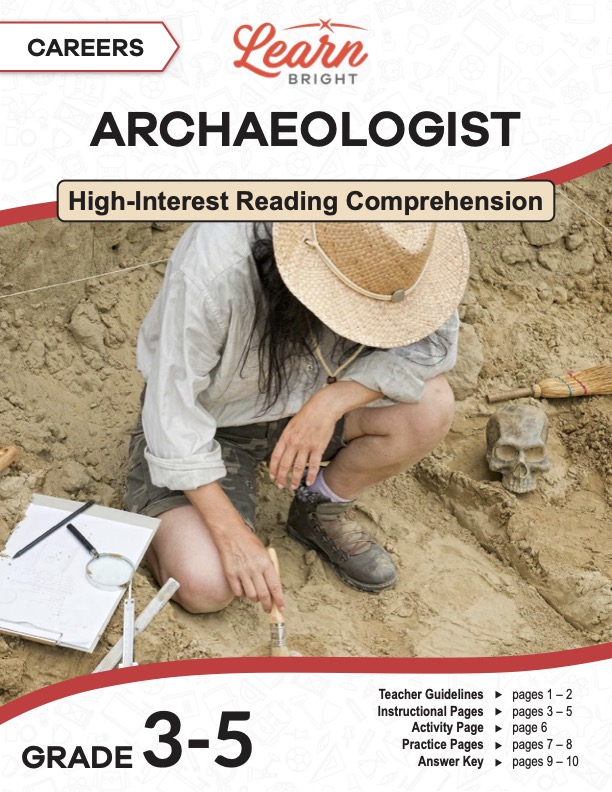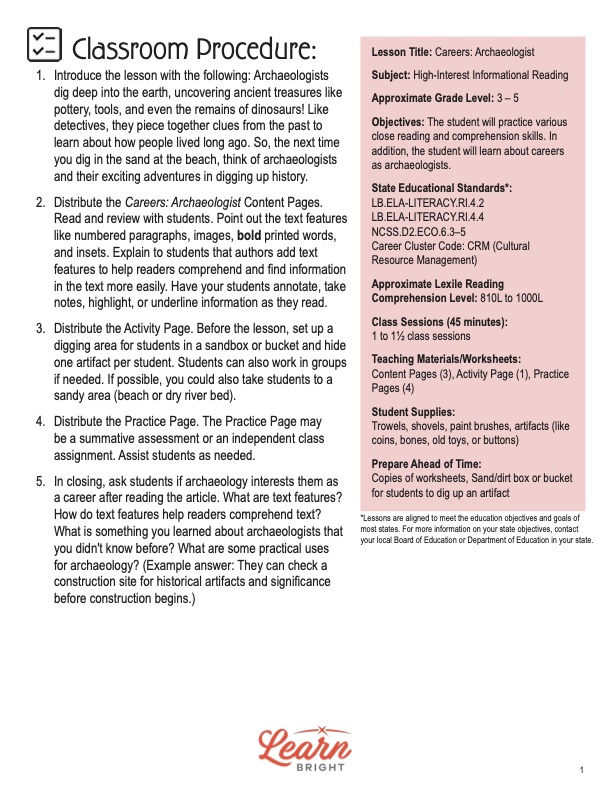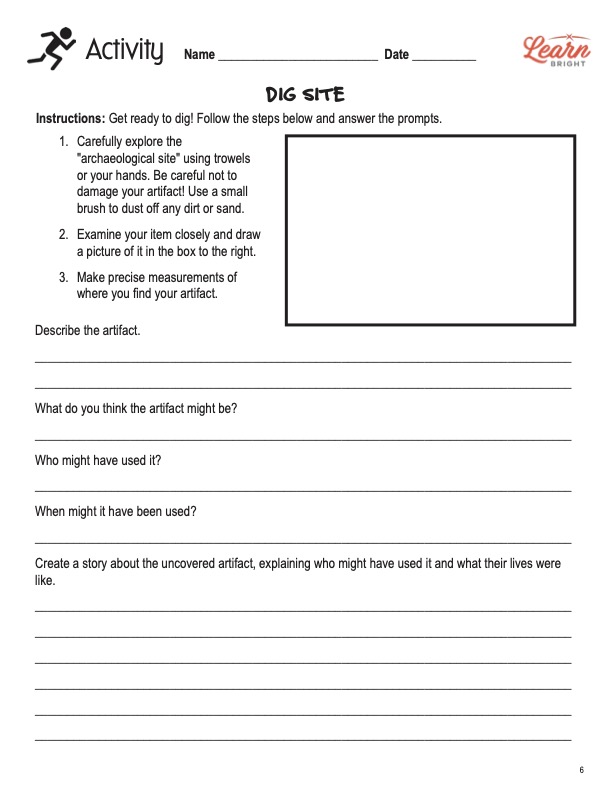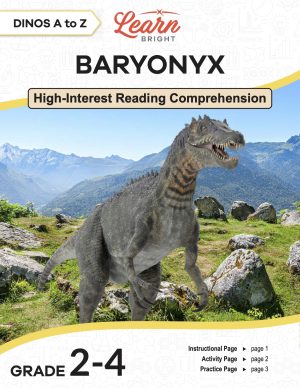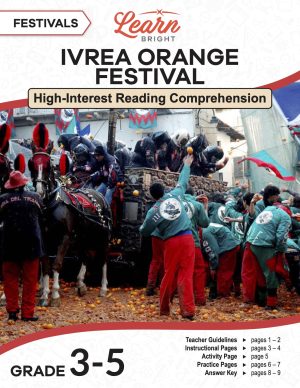Description
What our Careers: Archaeologist lesson plan includes
Lesson Objectives and Overview: Careers: Archaeologist is a high-interest reading comprehension lesson plan. As such, students will practice various close reading and comprehension skills. In addition, they will learn about the aspects of a career in archaeology. This lesson is for students in 3rd grade, 4th grade, and 5th grade.
Classroom Procedure
Every lesson plan provides you with a classroom procedure page that outlines a step-by-step guide to follow. You do not have to follow the guide exactly. The guide helps you organize the lesson and details when to hand out worksheets. It also lists information in the yellow box that you might find useful. You will find the lesson objectives, state standards, and number of class sessions the lesson should take to complete in this area. In addition, it describes the supplies you will need as well as what and how you need to prepare beforehand. The supplies you need for this lesson include trowels, shovels, paint brushes, and artifacts (like coins, bones, old toys, or buttons).
Teacher Notes
The teacher notes page provides an extra paragraph of information to help guide the lesson and remind you what to focus on. It explains that you can teach this lesson in a whole-class setting or as an independent, small-group activity. The blank lines on this page are available for you to write out thoughts and ideas you have as you prepare the lesson.
CAREERS: ARCHAEOLOGIST LESSON PLAN CONTENT PAGES
Introduction to Archaeology
The Careers: Archaeologist lesson plan contains three content pages. You may wonder why people ask you what you want to be when you grow up. After all, you’re just a kid! Well, it’s never too early to think about what you want to do when you’re not a kid. Now is the perfect time to explore cool jobs, like searching for old treasures! Archaeology is super exciting, and you might love learning about it.
If you’ve ever seen Indiana Jones digging up ancient artifacts or heard about scientists uncovering the mysteries of lost civilizations, you already have a glimpse of what archaeologists do. An archaeologist is like a history detective, unearthing clues from archaeological sites to piece together the story of our ancestors. Because of archaeologists, we know a lot about peoples and cultures from long ago, like the ancient Egyptians or ancient Romans. And, of course, we know about dinosaurs.
Technology
Archaeologists use all sorts of tools and gadgets to help them uncover the secrets of the past! One of the most essential tools is a trowel. A trowel is a small shovel archaeologists use to carefully dig and scrape away dirt around artifacts or bones without damaging them. They also use brushes to gently sweep away dirt and reveal delicate objects. But wait—there’s more!
Believe it or not, archaeologists also use metal detectors to find hidden underground treasures, such as ancient coins or jewelry. And if they’re exploring underwater sites, they might use special diving gear and underwater cameras to take pictures of sunken ships or lost cities. GPS, sonar, high-resolution cameras, and other high-tech tools they can use today.
And let’s not forget about aerial technology! Archaeologists use drones to take aerial photographs of dig sites. This helps them map out the area and discover hidden features that might be hard to see from the ground. They also use 3D scanners to create detailed digital models of artifacts and archaeological sites. They can study and analyze 3D images without ever touching the real thing!
Where Archaeologists Work
In the United States alone, thousands of archaeologists work in universities, museums, government agencies, and private consulting firms. And with ongoing discoveries and technological advancements, the demand for skilled archaeologists is only expected to grow in the coming years.
But what does this mean for you? For starters, pursuing a career in archaeology can lead to exciting opportunities and the chance to impact our understanding of the past. Whether it’s uncovering new archaeological sites, analyzing artifacts in a laboratory, or sharing discoveries with the public, archaeologists play a role in preserving our cultural heritage for future generations.
It’s not just about the intellectual thrill of uncovering ancient secrets, either. Archaeology offers a chance to connect with people from different cultures and backgrounds. Relationships with different cultures help us foster empathy and understanding across generations. By studying the past, archaeologists help us appreciate the world we live in and the importance of preserving our shared heritage.
Becoming an Archaeologist
What does it take to become an archaeologist? It all starts with a passion for history, a curiosity about the past, and a willingness to get your hands dirty. Most archaeologists hold a master’s degree in archaeology, anthropology, or a related field. Additionally, many pursue advanced degrees or certifications to specialize in a particular area of archaeology, such as underwater archaeology or bioarchaeology.
In addition to formal education, archaeologists also gain practical experience through fieldwork, internships, and volunteer opportunities. This hands-on training is essential for developing the skills and knowledge they need to succeed. According to the US Bureau of Labor Statistics, most archaeologists make around $64,000 depending on their education and experience.
A career in archaeology offers a combination of intellectual stimulation, cultural enrichment, and the opportunity to contribute to our understanding of the past. So, if you’re passionate about history and intrigued by the mysteries of ancient civilizations, consider becoming an archaeologist. Who knows? You might just uncover the next lost city, find a new extinct animal, or help preserve a piece of our shared heritage for generations to come!
CAREERS: ARCHAEOLOGIST LESSON PLAN WORKSHEETS
The Careers: Archaeologist lesson plan includes two worksheets: an activity worksheet and a practice worksheet. Each one will help students solidify their grasp of the material they learned throughout the lesson. You can refer to the classroom procedure guidelines to know when to hand out each worksheet.
DIG SITE ACTIVITY WORKSHEET
For this activity, students will carefully explore the “archaeological site” you prepared using trowels or their hands. They must be careful not to damage their artifacts and use a small brush to dust off any dirt or sand. After examining the item closely, students will draw a picture of it in the box on the right side of the page. They should also make precise measurements for where they found the artifact.
Once they’ve completed the first part of the assignment, students will respond to the prompts on the second half of the worksheet. The last prompt requires them to create a story surrounding the artifact they found.
CAREERS: ARCHAEOLOGIST PRACTICE WORKSHEET
The practice worksheet requires students to answer a series of 10 questions. These questions all relate to the content pages, so students will need to refer to them often for the answers. In addition, each question provides which reading tool the question corresponds to, such as text feature, vocabulary, or comprehension.
Worksheet Answer Keys
At the end of the lesson plan document is an answer key for the practice worksheet. The correct answers are all in red to make it easier for you to compare them with students’ responses. If you choose to administer the lesson pages to your students via PDF, you will need to save a new file that omits these pages. Otherwise, you can simply print out the applicable pages and keep these as reference for yourself when grading assignments.

